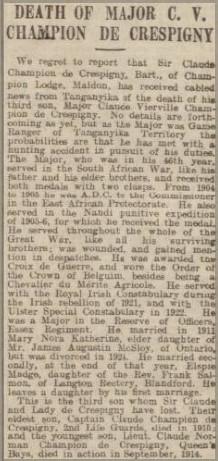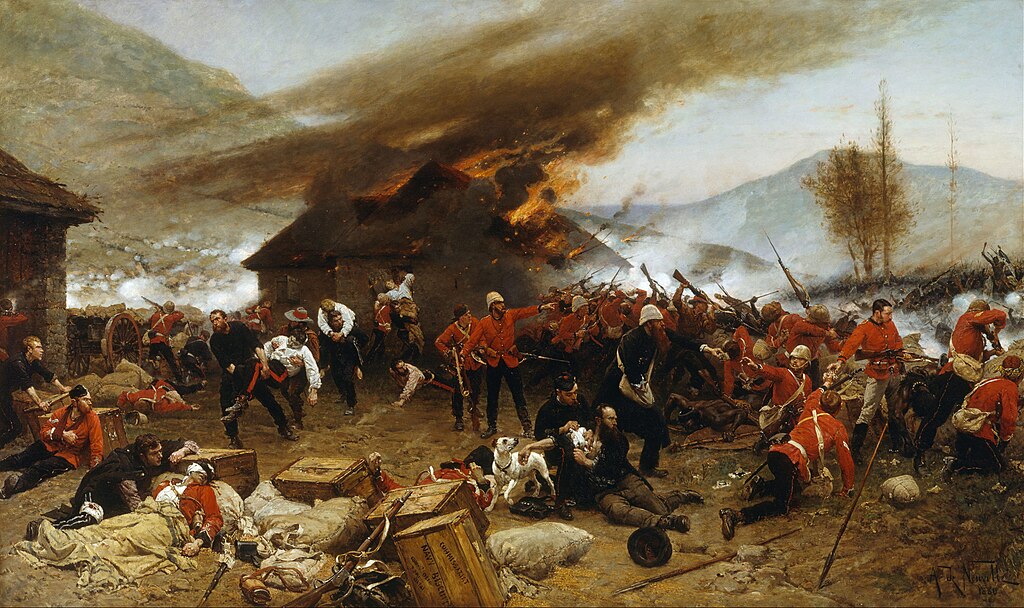Today is the 82nd anniversary of the beginning of the siege of Tobruk in 1941. My grandfather Richard Geoffrey Champion de Crespigny (1907 – 1966), known as Geoff de Crespigny, who served in the Second Australian Imperial Force as a doctor, was in Tobruk for nine months through the siege. His long enforced stay there earned him the nickname of `The old man of Tobruk’. He was mentioned in dispatches. Below is an extract from his diary.



5 Apr
The threat of attack by German and Iti forces has been growing the last few days, and today we felt the effects, as people started to return from forward area with various stories. Hundreds of sick are to be sent to 4 AGH. Luckily a hospital ship is expected soon.
6 Apr
The “flap” is on. The hospital took in about 400 patients in the last 24 hrs, and units and base personnel are streaming in. The air is full of rumours, and German patrols have been playing old Harry with our L of C [lines of communication], people leaving all at news of them and making for Tobruk.
2/3 CCS turned up again, less some equipment, and the rear party of the hospital likewise. An enemy patrol was captured just SW [southwest] of Tobruk. At one stage it was feared that an armoured column (Hun [i.e. German]) was on its way here direct across the desert. Since we had nothing to stop tanks, things looked sticky and it appeared to be more than likely that we would all become POW. Felt a bit disturbed, naturally, but there was nothing to be done about it. Talk of sending the nurses away on an awful little cargo boat, but the patrol turned out to be only a patrol, and it was decided, very wisely, to send them by Hosp[ital] Ship next day. I went about a bit on Alice [his motorcycle] on sundry commissions.
7 Apr
DDMS and DADMS Cyrcom [Colonels Walker and Furnell] turned up – very fed up at the nature of the rout which seems to have been quite complete, and we have lost much valuable equipment and personnel as POW. The 9 Div[ision: infantry] have done very well but were hopelessly under-equipped to withstand AFVs [armoured fighting vehicles: i.e. tanks, armoured cars etc] and the 2 Arm[oured] Div[ision], much of it in Iti tanks, had a hiding alas.
A hospital ship arrived and I went to 4 AGH to tee things up. Then to the wharf where no sign could be seen from the ship. She turned out to be the Vita – a hospital carrier, with accommodation for only 240 pts [patients], and we had over 400 and the nurses to go! Prepared to get all possible aboard, but matters held up as the ship’s launches broke down. Eventually got a large number aboard using various craft – the nurses went in a schooner! 18 Bde [Brigade] arrived, and I saw Gregory Bruer on the docks.
8 Apr
Arose early and got the remainder of the sick and the baggage aboard. We put 324 and the nurses onto the poor little chap.
Had a confab with McQuillan of 2/4 Field Hygiene Section as to functions. All POW labour has gone and we have to use Libyans, which makes things rather difficult. There are still many tales of the flap. The opposition is closing in, and all our troops that got away are now in Tobruk area. Heard, to my distress, that Roy Binns and his co[ompan]y of 2/8 Field Ambulance were captured. Also it appears that we have lost two generals, and poor old Colonel Godding, who stayed with us at HQ, was also captured. At the same time there have been remarkable escapes.
9 Apr
An air raid early in the morning. Nothing much happened. Rode out to POW cage to see about cleaning it. Frieberg [Fryberg] is to superintend. Did some more beetling about in the afternoon, and in the evening went to the hospital. When nearly home found a shoe heel missing, so returned and found it where I had started the bicycle. Nearly back again when the fireworks started and I spent a perfectly horrid ¾ hour lying in a shallow depression and hoping no AA stuff would land on me. Some bombs fell moderately close. Made one dash for it but was forced to ground again. Eventually got in, and went to the docks to inspect damage. There was an enormous hole on the dock – a 500 lb bomb it was thought.
10 Apr
A horrid dusty day, and spent most of the time indoors. Hoped to get out to the POW cage but dust prevented it. There was a lot of artillery fire all day. Ours we think! At 1800 hrs there was a fierce air raid, the objectives being apparently the two hospitals at town and beach – no other places attacked and it seemed quite deliberate. Chambers and Schwartz were killed and Row from 2/2 CCS severely wounded, and there were a number of casualties among patients and staff. Eric Cooper had an amazing escape, as a bomb fell within feet, and didn’t go off. We all felt very sick about it. Another raid in the evening, but no damage although bombs fell.

Australian War Memorial Accession Number 007578 Maker Hurley, James Francis (Frank); Place made North Africa: Libya, Cyrenaica, Tobruk Area, Tobruk; Date made 7 May 1941

Australian War Memorial Accession Number 007510 Maker Anderson, Alan Frederick; Place made North Africa: Libya, Cyrenaica, Tobruk Area, Tobruk; Date made c April 1941

Australian War Memorial: Accession Number 007501; Maker Hurley, James Francis (Frank); Place made North Africa: Libya, Cyrenaica, Tobruk Area, Tobruk; Date made c April 1941













